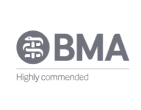Tricks to titrating noninvasive ventilation (NIV)
Previously, you learned tips on initiating noninvasive ventilation (NIV): avoid the use of sedative medications if possible, start with a single low pressure on the ventilator (i.e., continuous positive airway pressure, or CPAP, mode), and allow patients to hold the mask up to their face before tightly attaching the straps.
The real benefit of NIV is achieved when you choose the right mode of ventilation and adjust to the appropriate settings.
In order to get a handle on how to titrate NIV, let’s take a look at how to use NIV in two different patients.
Titrating NIV in patients with acute exacerbation of chronic obstructive pulmonary disease (AECOPD)
First, let’s take a look at Meryl, a 72-year-old woman with an acute exacerbation of chronic obstructive pulmonary disease (AECOPD).
Choose the right mode
For Meryl, with her AECOPD, we will want to choose bilevel positive airway pressure (BPAP) as our mode of NIV. Delivering two pressures, one during inspiration and one during expiration, will assist with ventilation, offload her respiratory muscles, and improve her airflow obstruction.
Meet the pressure goals
For Meryl to acclimate, we started with a continuous pressure of 2–3 cmH2O and then titrated up to a pressure of 5 cmH2O. To provide her with an inspiratory and expiratory pressure, we’ll want to add pressure support (PS) until we see a reduction in respiratory rate. To do this, we’ll increase by 2 cmH2O every five minutes to end up with a level between 7–10 cmH2O.
Monitor oxygen saturation
The fraction of inspired oxygen (FIO2) can be set anywhere between 21% and 100% to meet the saturation goals of the patient. For Meryl, we’ll want her oxygen saturation to be greater than 88%, and we’ll titrate the FIO2 to that goal.
Become a great clinician with our video courses and workshops
Titrating NIV in patients with acute respiratory failure
Now, let's consider Tom, a 67-year-old male with acute respiratory failure, perhaps from acute pulmonary edema.
Choosing the right mode
For Tom, continuous positive airway pressure (CPAP) is the preferred treatment option. Start with a low level of CPAP and increase the pressure by 2 cmH2O every few minutes. Just like with BPAP, the FIO2 can be titrated between 21% and 100% according to the patient’s saturation goals.
Meet the pressure goals
Studies of NIV on patients with pulmonary edema found a positive end-expiratory pressure (PEEP) level of 8–12 cmH2O provided clinical benefit for most patients.
Monitor effects on increased inspiratory pressures
As you titrate upwards, be mindful of the effects of increased inspiratory pressures.
With high pressures it is easier for the interface to leak, undoing any benefit from the increased pressure. Additionally, there is the risk of gastric insufflation as the pressure of air overcomes the pressure of the lower esophageal sphincter. When inspiratory pressure settings approach 25 cmH2O, one must consider intubation and invasive mechanical ventilation.
But don’t forget about tidal volume (VT). Since we are setting pressure and not volume, the VT will depend on the compliance of the patient’s lungs. High VT can cause volutrauma to the lungs that may lead to worse outcomes. To reduce this risk, adjust the inspiratory pressure and monitor the measured VT on the ventilator to achieve between 6 and 8 mL / kg of predicted body weight.
That’s it for now. If you want to improve your understanding of key concepts in medicine and improve your clinical skills, make sure to register for a free trial account, which will give you access to free videos and downloads. We’ll help you make the right decisions for yourself and your patients.
Recommended reading
- Allison, MG and Winters, ME. 2016. Noninvasive ventilation for the emergency physician. Emerg Med Clin North Am. 34: 51–62. PMID: 26614241
- Antonelli, M, Pennisi, MA, and Conti, G. 2003. New advances in the use of noninvasive ventilation for acute hypoxaemic respiratory failure. Eur Respir J Suppl. 42: 65s–71s. PMID: 12946003
- Meyer, TJ and Hill, NS. 1994. Noninvasive positive pressure ventilation to treat respiratory failure. Ann Intern Med. 120: 760–770. PMID: 8147550
- Patel, BK, Wolfe, KS, Pohlman, AS, et al. 2016. Effect of noninvasive ventilation delivered by helmet vs face mask on the rate of endotracheal intubation in patients with acute respiratory distress syndrome: a randomized clinical trial. JAMA. 315: 2435–2441. PMID: 27179847
Become an expert
Noninvasive Ventilation Masterclass

Mechanical Ventilation Essentials

Mechanical Ventilation Essentials Workshop



